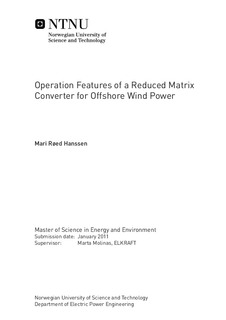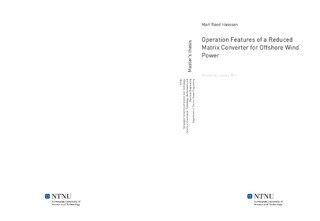| dc.contributor.advisor | Molinas, Marta | nb_NO |
| dc.contributor.author | Hanssen, Mari Røed | nb_NO |
| dc.date.accessioned | 2014-12-19T13:52:31Z | |
| dc.date.available | 2014-12-19T13:52:31Z | |
| dc.date.created | 2011-05-13 | nb_NO |
| dc.date.issued | 2011 | nb_NO |
| dc.identifier | 416955 | nb_NO |
| dc.identifier | ntnudaim:5809 | nb_NO |
| dc.identifier.uri | http://hdl.handle.net/11250/256999 | |
| dc.description.abstract | When a wind park is sited offshore, compact, lightweight and reliable components are important requirements. In this Master's thesis a wind energy conversion system has been proposed, where the objective is to meet the requirements of an offshore environment. The system consists of a permanent magnet generator, a reduced matrix converter, a high frequency transformer and a full-bridge converter. It is the reduced matrix converter which is the main focus of the thesis. The reduced matrix converter (RMC) provides direct AC-AC conversion without the need of a bulky DC link capacitor, it is thus a compact solution. It is built with six bi-directional switches. Each switch consists of two reverse blocking IGBTs in antiparallel. The reverse blocking IGBT is different from the conventional IGBT because it blocks voltage of both polarities.Due to the direct AC-AC conversion of the RMC it is necessary to implement a special protection scheme for the circuit. The scheme provides reliable operation of the RMC so the switches are not damaged. This is achieved by the introduction of a clamp circuit. The clamp circuit has been studied during normal operation and the operation during faults has been described. The entire WECS has been implemented in the simulation program PSIM to simulate behavior of the clamp circuit during normal operation and to calculate switching and clamp circuit losses. Both losses are related to the RMC, and are important for the study of the overall energy efficiency of the converter. Total losses have been compared for two different modulation techniques, these are carrier based modulation and space vector modulation. The simulation results indicated that space vector modulation is the most energy efficient solution for the system. | nb_NO |
| dc.language | eng | nb_NO |
| dc.publisher | Institutt for elkraftteknikk | nb_NO |
| dc.subject | ntnudaim:5809 | no_NO |
| dc.subject | SIE5 energi og miljø | no_NO |
| dc.subject | Elektrisk energiteknikk | no_NO |
| dc.title | Operation Features of a Reduced Matrix Converter for Offshore Wind Power | nb_NO |
| dc.type | Master thesis | nb_NO |
| dc.source.pagenumber | 95 | nb_NO |
| dc.contributor.department | Norges teknisk-naturvitenskapelige universitet, Fakultet for informasjonsteknologi, matematikk og elektroteknikk, Institutt for elkraftteknikk | nb_NO |

